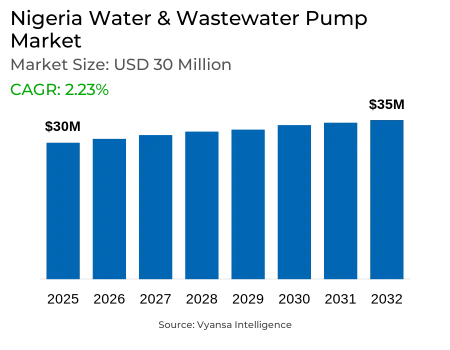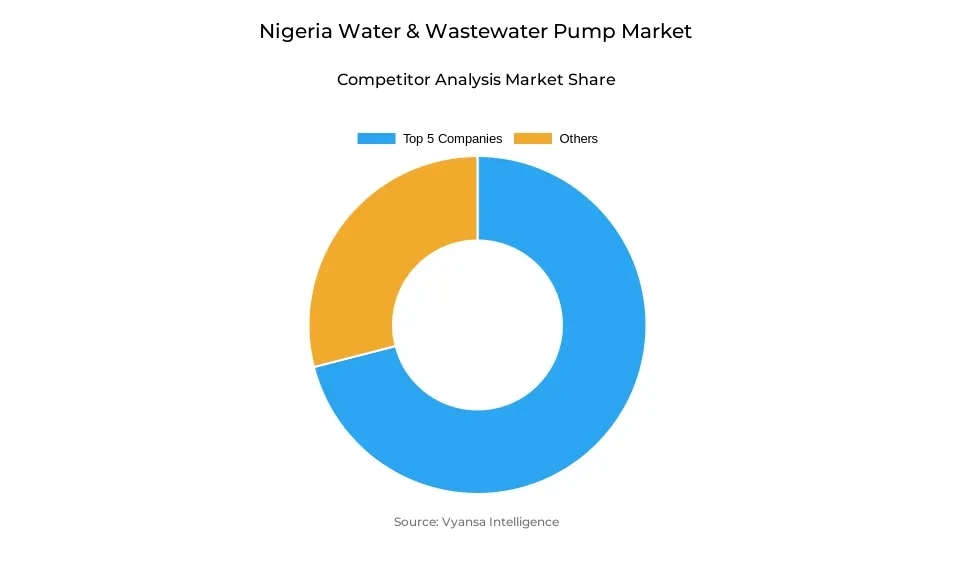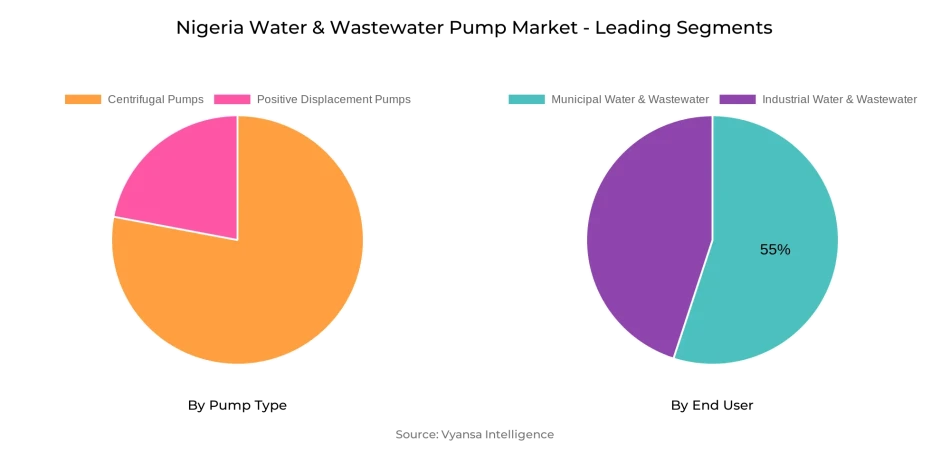Nigeria Water & Wastewater Pump Market Report: Trends, Growth and Forecast (2026-2032)
By Pump Type (Centrifugal Pumps (End Suction, Split Case, Vertical (Turbine, Axial Pump, Mixed Flow Pump), Submersible Pump), Positive Displacement Pumps (Progressing Cavity, Diaphragm, Gear Pump, Others)), By Application (Water, Wastewater), By End User (Industrial Water & Wastewater, Municipal Water & Wastewater)
- Energy & Power
- Dec 2025
- VI0485
- 110
-




Nigeria Water & Wastewater Pump Market Statistics and Insights, 2026
- Market Size Statistics
- Water & Wastewater Pump in Nigeria is estimated at $ 30 Million.
- The market size is expected to grow to $ 35 Million by 2032.
- Market to register a CAGR of around 2.23% during 2026-32.
- Pump Type Segment
- Centrifugal Pumps continues to dominate the market.
- Competition
- More than 10 companies are actively engaged in producing Water & Wastewater Pump in Nigeria.
- Top 5 companies acquired the maximum share of the market.
- ITT, IDEX, Dover, Flowserve, Sulzer AG etc., are few of the top companies.
- End User
- Municipal Water & Wastewater grabbed 55% of the market.
Nigeria Water & Wastewater Pump Market Outlook
The Nigeria water and wastewater pump market stands at USD 30 million in 2025 and is expected to grow to USD 35 million by 2032. Urbanization, with an average growth rate of the urban population at 3.45% in 2024, is putting huge pressure on water supply and wastewater networks. Almost 31.5% of Nigerians, more than 60 million individuals, remain without access to safe drinking water, making the demand for robust pumping systems to transport and treat water highly imperative.
Nigeria's old water infrastructure is strained, with recurring service outages in supply and wastewater systems. Few operating treatment plants contribute to environmental contamination and public health hazards. Utilities counter these problems by using smart pump controls, IoT-based sensors, and SCADA solutions to reduce energy consumption and raise operating effectiveness. Real-time monitoring and predictive maintenance reduce breakdowns, decrease expenditures, and boost delivery reliability in rapidly expanding urban areas.
Sanitation is another big issue, with approximately 75% of Nigerians without basic services, and space for massive wastewater pump installations. Closing this deficit is important in the reduction of waterborne diseases as well as land pollution, and provides scope for pump suppliers to aid government-initiated sewerage and treatment plant projects. Heavy-duty pumps' long-term demand will increase with Nigeria's speeding up of investments in sanitation infrastructure.
By pump type, the market is led by centrifugal pumps, with their low cost, flexibility, and capacity for handling diversified flow rates and pressures. Positive displacement pumps occupy specialized, small-scale uses. Municipal water and wastewater demand are the leaders on the demand side at 55% market share, a sign of widespread public investment, as the industrial segment grows most rapidly at a CAGR of 3.73% due to growth in the manufacturing and energy industries.

Nigeria Water & Wastewater Pump Market Growth Driver
Driving Forces in Infrastructure Investment and Compliance
Nigeria is undergoing rapid urbanization, with its urban population of 3.45% annually in 2024 putting increasing pressure on water supply and wastewater infrastructure to keep up with growing city populations.
At the same time, nearly 31.5% of Nigerians do not have access to safe drinking water, or more than 60 million people, making demand even greater for strong pumping solutions to move and treat water economically.
Nigeria Water & Wastewater Pump Market Challenge
Critical Water Loss and Energy Efficiency Challenges
Much of Nigeria's aging water infrastructure is under strain from rising demand, with disruptions to service in supply and wastewater systems a common occurrence. Lack of operational treatment facilities results in public health issues and environmental contamination, posing a critical challenge for pump operators and local governments to ensure a continuous supply.
Nigeria Water & Wastewater Pump Market Trend
Rising Adoption of Intelligent Pumping Solutions
Nigerian water utilities are increasingly adopting smart pump controls and remote monitoring solutions to streamline energy usage and reduce operating costs. As a major portion of utility bills is made up of electricity charges, real-time adaptable smart pumping systems are becoming essential. Utilities are installing IoT-based sensors, SCADA systems, and data analytics solutions to monitor pump performance, water pressure, and minimize downtime.
The addition of predictive maintenance through advanced analytics is also spurring adoption. By detecting likely failures prior to breakdowns, operators can minimize expensive emergency repairs and maximize equipment life. These digital technologies also improve the reliability of water delivery across Nigeria's fast-expanding urban areas, where population pressures continue to stretch out ageing water infrastructure.
Nigeria Water & Wastewater Pump Market Opportunity
Expanding Wastewater Infrastructure Needs
Notwithstanding significant strides in access to clean water, an estimated 75% of Nigerians remain without basic sanitation services. This sweeping service deficit presents a wastewater pump installation opportunity for promoting sewerage expansion and upgraded treatment systems. Lacking sanitation remains a contributing factor in waterborne diseases and land pollution, compelling the government and private sector to invest in large-scale wastewater projects.
Pump suppliers are likely to gain as Nigeria increases investment in sewage systems, pumping facilities, and sewage treatment plants. Closing this gap not only enhances public health but also stimulates long-term demand for heavy-duty, high-capacity pumps. By coordinating solutions with Nigeria's sanitation development objectives, pump suppliers will be able to establish themselves in the key projects of the future.
Nigeria Water & Wastewater Pump Market Segmentation Analysis

By Pump Type
- Centrifugal Pumps
- Positive Displacement Pumps
The most dominant market segment in terms of pump type is Centrifugal Pumps, which remain preeminent because of their relative simplicity, versatility, and low cost. Centrifugal Pumps are capable of moving a vast array of flow rates and pressures, and therefore find application in the majority of municipal and industrial water uses.
Positive Displacement Pumps, although necessary for niche high-pressure or viscous-fluid applications, hold a smaller share, further validating centrifugal technology as Nigeria's water and wastewater infrastructure pillar.
By End User
- Industrial Water & Wastewater
- Municipal Water & Wastewater
The most dominant end user segment with the largest market share is Municipal Water & Wastewater, accounting for 55% of the market. This strong presence is an indication of widespread public investment in city water supply networks and treatment plants for sewage.
Industrial Water & Wastewater is the fastest growing end user segment, with a CAGR of 3.73% due to manufacturing and energy industries growing and thus causing demand for effective process water and effluent management solutions.
Top Companies in Nigeria Water & Wastewater Pump Market
The top companies operating in the market include ITT, IDEX, Dover, Flowserve, Sulzer AG, KSB, Xylem, Grundfos, Ebara, SPX Flow, etc., are the top players operating in the Nigeria Water & Wastewater Pump Market.
Frequently Asked Questions
Related Report
1. Market Segmentation
1.1. Research Scope
1.2. Research Methodology
1.3. Definitions and Assumptions
2. Executive Summary
3. Nigeria Water & Wastewater Pump Market Policies, Regulations, and Standards
4. Nigeria Water & Wastewater Pump Market Dynamics
4.1. Growth Factors
4.2. Challenges
4.3. Trends
4.4. Opportunities
5. Nigeria Water & Wastewater Pump Market Statistics, 2022-2032F
5.1. Market Size & Growth Outlook
5.1.1.By Revenues in US$ Million
5.2. Market Segmentation & Growth Outlook
5.2.1.By Pump Type
5.2.1.1. Centrifugal Pumps- Market Insights and Forecast 2022-2032, USD Million
5.2.1.1.1. End Suction- Market Insights and Forecast 2022-2032, USD Million
5.2.1.1.2. Split Case- Market Insights and Forecast 2022-2032, USD Million
5.2.1.1.3. Vertical- Market Insights and Forecast 2022-2032, USD Million
5.2.1.1.3.1. Turbine- Market Insights and Forecast 2022-2032, USD Million
5.2.1.1.3.2. Axial Pump- Market Insights and Forecast 2022-2032, USD Million
5.2.1.1.3.3. Mixed Flow Pump- Market Insights and Forecast 2022-2032, USD Million
5.2.1.1.4. Submersible Pump- Market Insights and Forecast 2022-2032, USD Million
5.2.1.2. Positive Displacement Pumps- Market Insights and Forecast 2022-2032, USD Million
5.2.1.2.1. Progressing Cavity- Market Insights and Forecast 2022-2032, USD Million
5.2.1.2.2. Diaphragm- Market Insights and Forecast 2022-2032, USD Million
5.2.1.2.3. Gear Pump- Market Insights and Forecast 2022-2032, USD Million
5.2.1.2.4. Others- Market Insights and Forecast 2022-2032, USD Million
5.2.2.By Application
5.2.2.1. Water- Market Insights and Forecast 2022-2032, USD Million
5.2.2.2. Wastewater- Market Insights and Forecast 2022-2032, USD Million
5.2.3.By End User
5.2.3.1. Industrial Water & Wastewater- Market Insights and Forecast 2022-2032, USD Million
5.2.3.2. Municipal Water & Wastewater- Market Insights and Forecast 2022-2032, USD Million
5.2.4.By Competitors
5.2.4.1. Competition Characteristics
5.2.4.2. Market Share & Analysis
6. Nigeria Centrifugal Water & Wastewater Pump Market Statistics, 2020-2030F
6.1. Market Size & Growth Outlook
6.1.1.By Revenues in US$ Million
6.2. Market Segmentation & Growth Outlook
6.2.1.By Pump Type- Market Insights and Forecast 2022-2032, USD Million
6.2.2.By Application- Market Insights and Forecast 2022-2032, USD Million
6.2.3.By End User- Market Insights and Forecast 2022-2032, USD Million
7. Nigeria Positive Displacement Water & Wastewater Pump Market Statistics, 2020-2030F
7.1. Market Size & Growth Outlook
7.1.1.By Revenues in US$ Million
7.2. Market Segmentation & Growth Outlook
7.2.1.By Pump Type- Market Insights and Forecast 2022-2032, USD Million
7.2.2.By Application- Market Insights and Forecast 2022-2032, USD Million
7.2.3.By End User- Market Insights and Forecast 2022-2032, USD Million
8. Competitive Outlook
8.1. Company Profiles
8.1.1.Flowserve Corporation
8.1.1.1. Business Description
8.1.1.2. Product Portfolio
8.1.1.3. Collaborations & Alliances
8.1.1.4. Recent Developments
8.1.1.5. Financial Details
8.1.1.6. Others
8.1.2.Ebara Corporation
8.1.2.1. Business Description
8.1.2.2. Product Portfolio
8.1.2.3. Collaborations & Alliances
8.1.2.4. Recent Developments
8.1.2.5. Financial Details
8.1.2.6. Others
8.1.3.WILO SE
8.1.3.1. Business Description
8.1.3.2. Product Portfolio
8.1.3.3. Collaborations & Alliances
8.1.3.4. Recent Developments
8.1.3.5. Financial Details
8.1.3.6. Others
8.1.4.Sulzer Limited
8.1.4.1. Business Description
8.1.4.2. Product Portfolio
8.1.4.3. Collaborations & Alliances
8.1.4.4. Recent Developments
8.1.4.5. Financial Details
8.1.4.6. Others
8.1.5.Grundfos Holding A/S
8.1.5.1. Business Description
8.1.5.2. Product Portfolio
8.1.5.3. Collaborations & Alliances
8.1.5.4. Recent Developments
8.1.5.5. Financial Details
8.1.5.6. Others
8.1.6.Xylem Inc.
8.1.6.1. Business Description
8.1.6.2. Product Portfolio
8.1.6.3. Collaborations & Alliances
8.1.6.4. Recent Developments
8.1.6.5. Financial Details
8.1.6.6. Others
8.1.7.KSB SE & Co. KGaA
8.1.7.1. Business Description
8.1.7.2. Product Portfolio
8.1.7.3. Collaborations & Alliances
8.1.7.4. Recent Developments
8.1.7.5. Financial Details
8.1.7.6. Others
8.1.8.Kirloskar Brothers Limited (KBL)
8.1.8.1. Business Description
8.1.8.2. Product Portfolio
8.1.8.3. Collaborations & Alliances
8.1.8.4. Recent Developments
8.1.8.5. Financial Details
8.1.8.6. Others
8.1.9.Franklin Electric
8.1.9.1. Business Description
8.1.9.2. Product Portfolio
8.1.9.3. Collaborations & Alliances
8.1.9.4. Recent Developments
8.1.9.5. Financial Details
8.1.9.6. Others
8.1.10. Pentair PLC
8.1.10.1. Business Description
8.1.10.2. Product Portfolio
8.1.10.3. Collaborations & Alliances
8.1.10.4. Recent Developments
8.1.10.5. Financial Details
8.1.10.6. Others
9. Disclaimer
| Segment | Sub-Segment |
|---|---|
| By Pump Type |
|
| By Application |
|
| By End User |
|
Research Methodology
This study followed a structured approach comprising four key phases to assess the size and scope of the electro-oxidation market. The process began with thorough secondary research to collect data on the target market, related markets, and broader industry context. These findings, along with preliminary assumptions and estimates, were then validated through extensive primary research involving industry experts from across the value chain. To calculate the overall market size, both top-down and bottom-up methodologies were employed. Finally, market segmentation and data triangulation techniques were applied to refine and validate segment-level estimations.
Secondary Research
The secondary research phase involved gathering data from a wide range of credible and published sources. This step helped in identifying industry trends, defining market segmentation, and understanding the market landscape and value chain.
Sources consulted during this phase included:
- Company annual reports, investor presentations, and press releases
- Industry white papers and certified publications
- Trade directories and market-recognized databases
- Articles from authoritative authors and reputable journals
- Gold and silver standard websites
Secondary research was critical in mapping out the industry's value chain and monetary flow, identifying key market segments, understanding regional variations, and tracking significant industry developments.
Other key sources:
- Financial disclosures
- Industry associations and trade bodies
- News outlets and business magazines
- Academic journals and research studies
- Paid industry databases
Primary Research
To validate secondary data and gain deeper market insights, primary research was conducted with key stakeholders across both the supply and demand sides of the market.
On the demand side, participants included decision-makers and influencers from end-user industries—such as CIOs, CTOs, and CSOs—who provided first-hand perspectives on market needs, product usage, and future expectations.
On the supply side, interviews were conducted with manufacturers, industry associations, and institutional participants to gather insights into current offerings, product pipelines, and market challenges.
Primary interviews provided critical inputs such as:
- Market size and revenue data
- Product and service breakdowns
- Market forecasts
- Regional and application-specific trends
Stakeholders consulted included:
- Leading OEM and solution providers
- Channel and distribution partners
- End users across various applications
- Independent consultants and industry specialists
Market Size Estimation and Data Triangulation
- Identifying Key Market Participants (Secondary Research)
- Goal: To identify the major players or companies in the target market. This typically involves using publicly available data sources such as industry reports, market research publications, and financial statements of companies.
- Tools: Reports from firms like Gartner, Forrester, Euromonitor, Statista, IBISWorld, and others. Public financial statements, news articles, and press releases from top market players.
- Extracting Earnings of Key Market Participants
- Goal: To estimate the earnings generated from the product or service being analyzed. This step helps in understanding the revenue potential of each market player in a specific geography.
- Methods: Earnings data can be gathered from:
- Publicly available financial reports (for listed companies).
- Interviews and primary data sources from professionals, such as Directors, VPs, SVPs, etc. This is especially useful for understanding more nuanced, internal data that isn't publicly disclosed.
- Annual reports and investor presentations of key players.
- Data Collation and Development of a Relevant Data Model
- Goal: To collate inputs from both primary and secondary sources into a structured, data-driven model for market estimation. This model will incorporate key market KPIs and any independent variables relevant to the market.
- Key KPIs: These could include:
- Market size, growth rate, and demand drivers.
- Industry-specific metrics like market share, average revenue per customer (ARPC), or average deal size.
- External variables, such as economic growth rates, inflation rates, or commodity prices, that could affect the market.
- Data Modeling: Based on this data, the market forecasts are developed for the next 5 years. A combination of trend analysis, scenario modeling, and statistical regression might be used to generate projections.
- Scenario Analysis
- Goal: To test different assumptions and validate how sensitive the market is to changes in key variables (e.g., market demand, regulatory changes, technological disruptions).
- Types of Scenarios:
- Base Case: Based on current assumptions and historical data.
- Best-Case Scenario: Assuming favorable market conditions, regulatory environments, and technological advancements.
- Worst-Case Scenario: Accounting for adverse factors, such as economic downturns, stricter regulations, or unexpected disruptions.
Partnering With Industry Leaders to Drive Growth
Our mission is to deliver intelligence that matters. By combining data, analysis, and industry expertise, we enable organizations to make smarter, faster, and more impactful decisions. Whether it’s a Fortune 500 company or a high-growth startup, businesses trust us to provide clarity in an ever-evolving marketplace.






